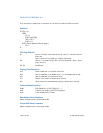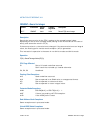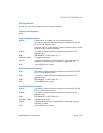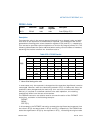
3-374 Vol. 2A FSAVE/FNSAVE—Store x87 FPU State
INSTRUCTION SET REFERENCE, A-M
instructions separately. If an exception is generated for either of these instructions,
the save EIP points to the instruction that caused the exception.
This instruction’s operation is the same in non-64-bit modes and 64-bit mode.
IA-32 Architecture Compatibility
For Intel math coprocessors and FPUs prior to the Intel Pentium processor, an FWAIT
instruction should be executed before attempting to read from the memory image
stored with a prior FSAVE/FNSAVE instruction. This FWAIT instruction helps insure
that the storage operation has been completed.
When operating a Pentium or Intel486 processor in MS-DOS compatibility mode, it is
possible (under unusual circumstances) for an FNSAVE instruction to be interrupted
prior to being executed to handle a pending FPU exception. See the section titled
“No-Wait FPU Instructions Can Get FPU Interrupt in Window” in Appendix D of the
Intel® 64 and IA-32 Architectures Software Developer’s Manual, Volume 1, for a
description of these circumstances. An FNSAVE instruction cannot be interrupted in
this way on a Pentium 4, Intel Xeon, or P6 family processor.
Operation
(* Save FPU State and Registers *)
DEST[FPUControlWord] ← FPUControlWord;
DEST[FPUStatusWord] ← FPUStatusWord;
DEST[FPUTagWord] ← FPUTagWord;
DEST[FPUDataPointer] ← FPUDataPointer;
DEST[FPUInstructionPointer] ← FPUInstructionPointer;
DEST[FPULastInstructionOpcode] ← FPULastInstructionOpcode;
DEST[ST(0)] ← ST(0);
DEST[ST(1)] ← ST(1);
DEST[ST(2)] ← ST(2);
DEST[ST(3)] ← ST(3);
DEST[ST(4)]← ST(4);
DEST[ST(5)] ← ST(5);
DEST[ST(6)] ← ST(6);
DEST[ST(7)] ← ST(7);
(* Initialize FPU *)
FPUControlWord ← 037FH;
FPUStatusWord ← 0;
FPUTagWord ← FFFFH;
FPUDataPointer ← 0;
FPUInstructionPointer ← 0;
FPULastInstructionOpcode ← 0;


















